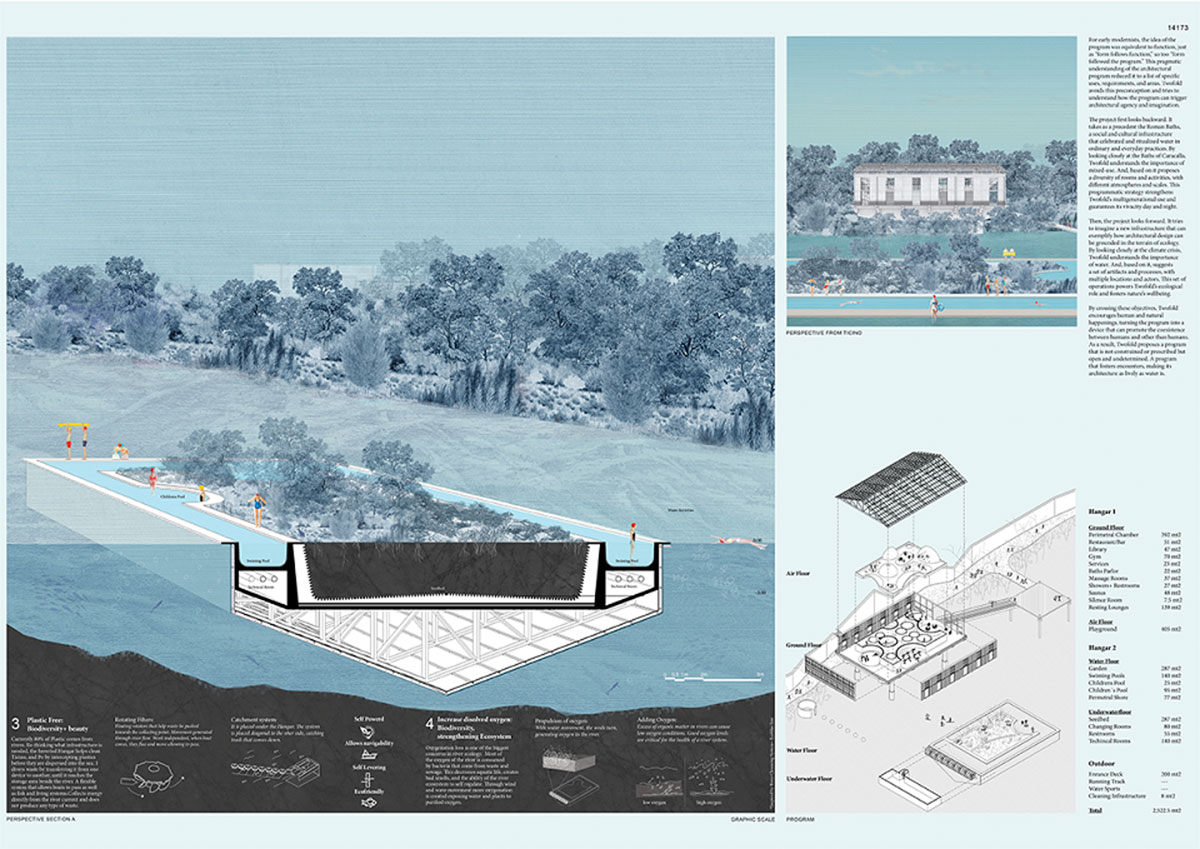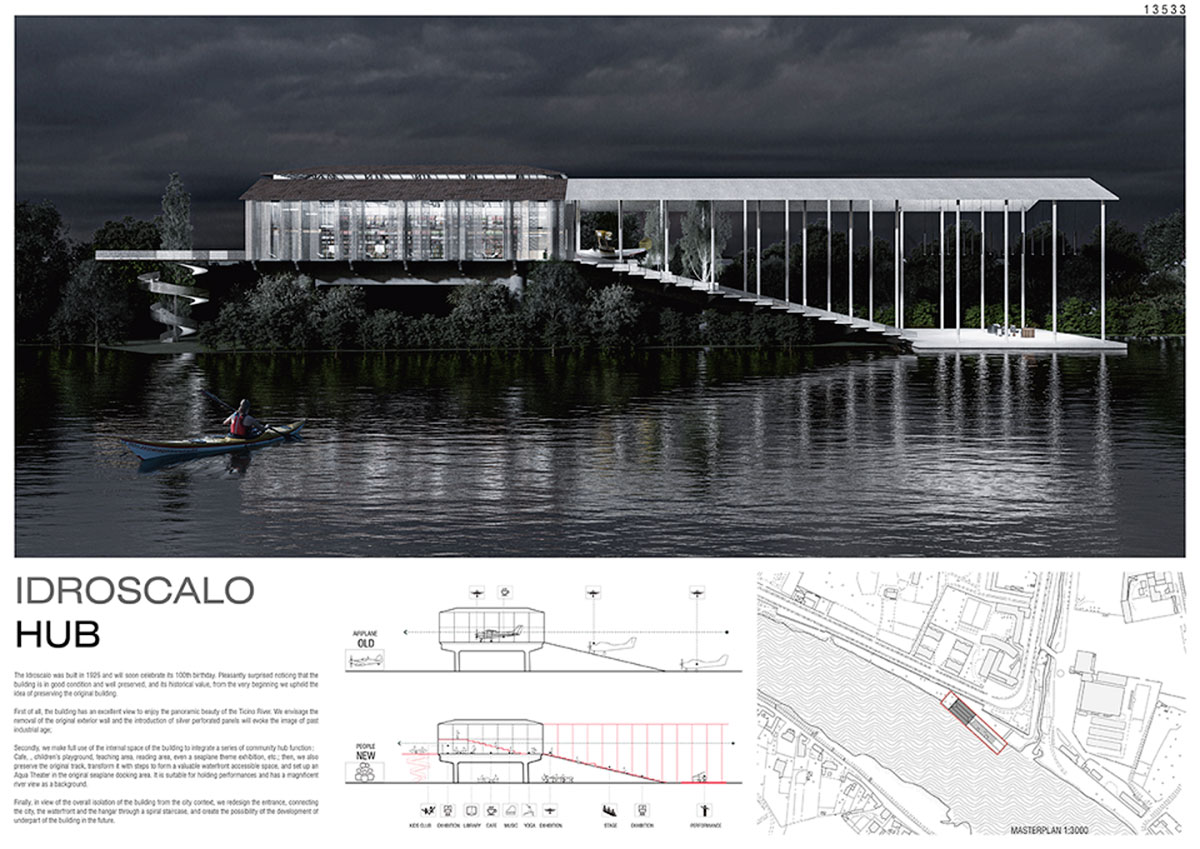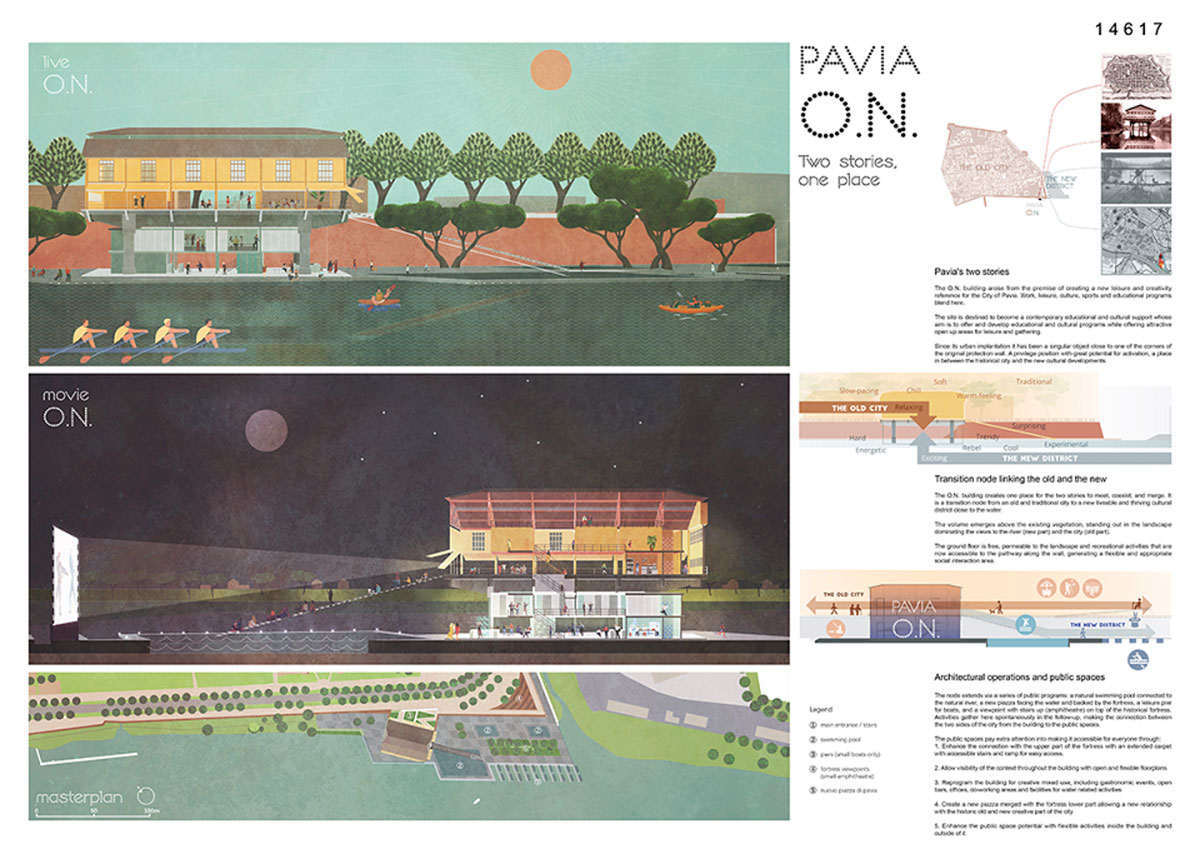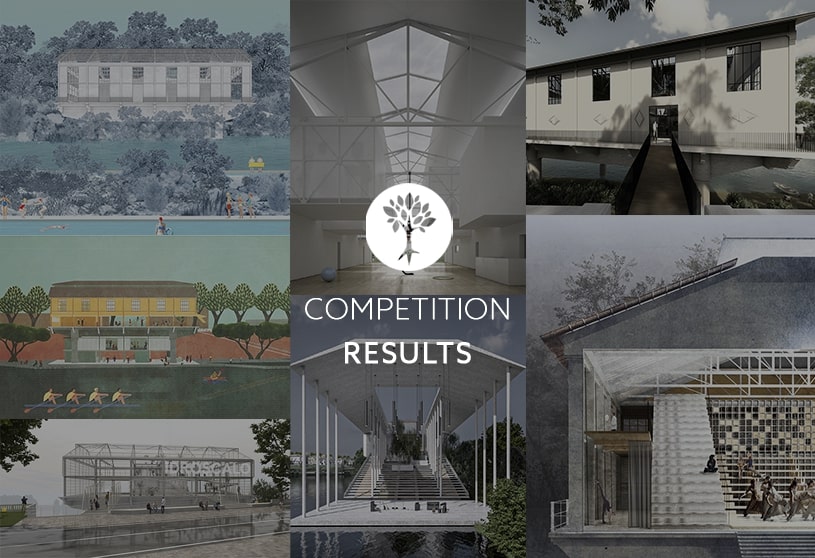TerraViva Competitions has officially released the complete list of awarded projects of the design contest “Hangar Ticinum”.
The unquestionable historical and artistic value of the “Idroscalo”, the uniqueness of its architectural typology and the worrying state of decay in which the building has been for decades, are just some of the reasons that motivated the idea of this competition. “Hangar Ticinum” challenged participants to imagine a full recovery of the hydroplane base with the ambition of restoring the importance and centrality it once had for the city of Pavia.
The awarded proposals were able to enhance the architectural characteristics of the original project by combining contemporary design interventions with flexible and interactive programs open to the local community.
TerraViva thanks all the competitors for participating in this competition and for contributing to the research within the framework of the rehabilitation of the Italian architectural heritage.

Organized by TerraViva Competitions, in collaboration with the Municipality of Pavia, the competition was open to students, architects, designers, artists, makers, activists and anyone interested in the fields of design an architecture.
The winners were selected by an international jury panel composed by:
- German Fuenmayor (Caracas | Piuarch)
- Anastasia Kucherova (Moscow | Stefano Boeri Architetti)
- Lorenzo Degli Esposti (Milan | Degli Esposti Architetti)
- Filippo Imberti (Berlin | TSPA)
- Lucia Paci (New York | Operastudio)
- Bogdan Peric (Belgrade | Untitled Architecture)
- Toufic Rifai (Beirut | Politecnico di Milano)
- Mariangela Singali Calisti (Municipality of Pavia | Culture Department)
1st Prize
Project by: Paulina Pawlikowska, Paulina Górecka
Poland

“The House of Light”
The existing Idroscalo building has always played an important role in the life of the city, being a transit point, a shelter, a terraceand a landmark in the panorama of Pavia, where life has revolved around the river since its beginnings. By introducing light into the space we try to invite passers-by to the city and to the interior of the building, thus restoring its original function. The permanent structure is filled with glass, which will bring light outside the building. With the help of light the existing structure will again become a luminous point on the city map, inviting people from all directions.
By creating terraces in the interior, the building will connect the city with the river, creating new perspectives for the perception of the city. The form of the building draws inspiration from the Shakespearean theater typology, creating many different scenarios for using the building and enjoying the performances inside and outside on the river. Visitors to the building create a shadow play on the façade, thus making their presence felt in the space.
Skids that were once used to lift hydrofoils inside are now symbolically pulled inside the building, thus creating a new hierarchy of space. Platforms with seats will be placed on them, which will naturally create a stage for performance space – theater. The result is a stage in the middle of the building surrounded by terraces. The interior is created by moving platforms that leave the floor, offering different configurations of scenes and possible scenarios for events in the building space.

2nd Prize
Project by: Devin Dobrowolski
USA

“Fata Morgana”
The project takes its name from the Fata Morgana, an atmospheric mirage making objects appear to hover just above the horizon. As in the myth of Morgan le Fay, a sorceress attributed with the power of transformation, the renovated Idroscalo retains the form of Pagano’s original design, but is given new life through a minimal but radical material intervention that transforms the disused hangar from a site of ruin, to a new form of flexible public space.
Taking cues from the abundant spontaneous vegetation of the site, the building operates like a greenhouse. After removing the brick and stucco infill, and reinforcing the existing concrete structure, the building is reclad in a lightweight, translucent polycarbonate skin that modulates light and temperature. In warm weather, the facade of the building opens almost entirely to allow for cross ventilation and expansive views along the Ticino. In cooler months, the polycarbonate allows for solar gain and traps heat.
Steel construction is used to shore up the existing concrete structure at maximum efficiency and minimum cost. A lightweight deck suspended from a series of pinned arches holds a central greenhouse with flexible work, meeting, and gathering space that can be accessed by stair and ramp. On the ground level, a central enclosure holds bathrooms and space for a small cafe and bar. The addition of this minimal but essential services maximizes and amplifies the greatest assets of the existing building–an expansive open space with expressed structure that creates a new indoor and outdoor public plaza at the gateway to the city.

3rd Prize
Project by: Valeria Paez Cala, Luisa Brando
Colombia/USA, Spain/USA

“TWOFOLD: a Water Infrastructure that Heals”
Twofold is a project that emerges from understanding that the enchantment of Hangar Ticinum’s ruin is due to its double essence that encapsulates Pagano’s rationale and Ticino’s wilderness. The project departs from this dichotomy and proposes an intervention that preserves this condition by buttressing and blending human interactions and natural processes.
The essence of the project is double, and so is its program. To reactivate the structure and the river, Twofold suggests two programs that heal through water. The first heals the human body, mind, and spirit with a complex of public baths, echoing the infrastructures of the Roman Empire. The second regenerates the river processes, biodiversity, and borders with a network of cleansing and seeding operations, engaging with climate change.
The essence of the project is double, and so is its architecture. To accommodate the activities, Twofold proposes two structures. The first is the reconstructed Hangar, with an intervention that restores Pagano’s initial logic and respects its structure, envelope, and roof. The second is its inversion, a floating shed traveling along Ticino, that energizes the river’s borders and unveils a new perspective of the city from inside the water.
When conceived, Hangar Ticinum was part of Pavia’s infrastructure to support its growth and prosperity. This lifted structure, disconnected from its landscape, embodied the principles of modernity, glorifying and sheltering man and his technologies. Twofold honors the initial project’s infrastructural origin. However, it redefines its scope by sheltering multiple forms of life and honoring water as the fundamental foundation.

Golden Mention
Project by: Di Feng, Lifang Zhang
China

“Idroscalo Hub”
The Idroscalo was built in 1926 and will soon celebrate its 100th birthday. Since we are pleasantly surprised to find that the building is well preserved, from the very beginning we have the idea of preserving the original building.
First of all, the building has an excellent riverside landscape to enjoy the beauty of the ticino river. We envisage the removal of the original exterior wall and the introduction of silver perforated panels will evoke the image of planes; secondly, we make full use of the internal space of the building to integrate a series of functions of the community hub:Coffee, seaplane theme exhibition, children’s playground, teaching area, reading area, etc.; then, we also preserve the original track, transform it with steps to form a valuable waterfront accessible space, and set up an open air stage in the original seaplane docking area. It is suitable for holding performances and has a magnificent river view as a background.
Finally, in view of the overall isolation of the building from the environment, we redesign the entrance, connecting the city, the waterfront and the hangar through a spiral staircase, and create the possibility of reuse the underpart of the building in the future development.

Golden Mention
Project by: Cecilia Marcheschi, Carlotta Di Sandro
Italy

“ACT – Art Center Ticinum”
In the 1920s Giuseppe Pagano designed the seaplane base of Pavia. A building born to be both a point of departure and of arrival, a static container of dynamic and passing objects. It’s from this reflection that our desire of reinterpretation arose, thinking of the hangar not as a container of objects anymore, but instead of thoughts, culture and art. In order to highlight the historic relevance of the artifact we decided to intervene mostly on the interiors of the building, keeping the essential characteristics of the seaplane base, a choice encouraged by the unpredictability of the context in which it’s set.
The most relevant external interventions are in fact limited to the construction of the two channels: the walkway, that leads from the road to the entrance, and the helical stairs that, like a vortex coming out of the river, connects the shore to the building. The project, developed on two levels, offers a glimpse of the city. On the upper level there are various volumes hosting artistic labs that overlook a long U-shaped walkway; this walkway is thought as a city street in which the relentless succession of buildings saturates the space.
The cubes facing the walkway allow only but a few glimpses towards the lower level, highlighting the privacy aspect of these activities. The space, on the contrary, decompresses in the central area, an area conceived as a town square, which becomes the crux of the project, place where the various arts come to play. The large public multifunctional space in fact preserves the original height of the building and opens up with a large stained glass window over the river, abandoning any form of intimacy.

Golden Mention
Project by: Shuangyun Chen, Raúl Martínez Medina
China, Mexico

“PAVIA O.N: Two Stories, One Place”
The O.N. building arose from the premise of creating a new leisure and creativity reference for the City of Pavia. Work, leisure, culture, sports and education blend here smoothly. It has a privilege position to link the historical city and the new cultural waterfront developments together. The building serves as a node linking the old and the new, a place where the two stories meet and merge. It’s the transition point from an old and traditional city to a new liveable and thriving cultural district close to the water.
It frames up the programs in sections: the upper floors attached to the old city inherits the feeling of tradition, elegance, relaxation, and warmth from the historical city wall, while the lower floors invite the bold, pioneer, and experimental nature of the new district. It welcomes people of different ages, preferences, and ideas to work and play together.
Floors are open, free and permeable to the landscape and recreational activities surrounding the area, a place appropriate for social interaction where activities gather spontaneously in the follow-up, making the connection between the two sides of the city. Inside the building the entrance hall and audio visual rooms are flexible to become collaborative offices, workshops or places of discussion while incorporating other functions such as restaurant, caffe and open bar, new elements that allow the community to gather and enjoy the cultural gastronomic heritage of Pavia. A building that evolves and transforms with Pavia’s citizens and visitors.

Golden Mention
Project by: Giuseppe D’Albenzio
Italy

“Box for Culture”
Convinced of a respectful recovery of the artifact for its typological uniqueness and for its historical-artistic value, the concept imagines the re-functionalization of the large internal space of the seaplane base. The planned functions are: an auditorium, a room for impromptu exhibitions and a literary café.
The project transforms the empty and abandoned space of the seaplane base into a “Box for Culture”. A reference point for the community of Pavia, a city of great cultural and artistic wealth, where you can organize events, musical concerts, conferences, screenings, exhibitions, but at the same time a place where you can meet and socialize through a literary café with a bookshop, all set in an exceptional panoramic position. A simple idea that highlights the architectural and landscape features of the building, enhancing the internal and external relationship, restoring dignity and respect without ever trampling the spirit of Giuseppe Pagano’s work. A good compromise between the historical memory of the building and the new intended use.

“Our memory is our consistency, our reason, our feeling, even our actions. Without it we are nothing”.
